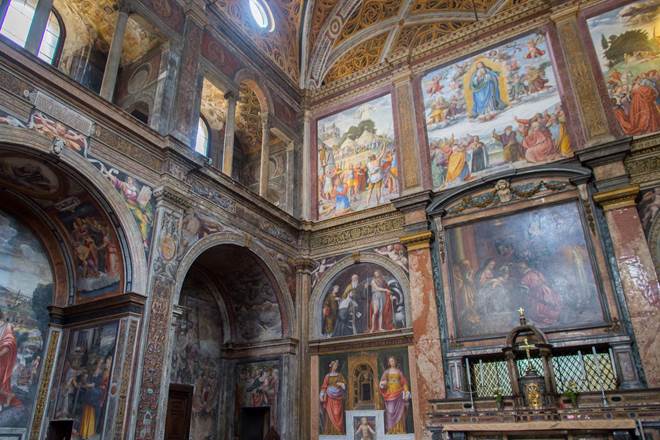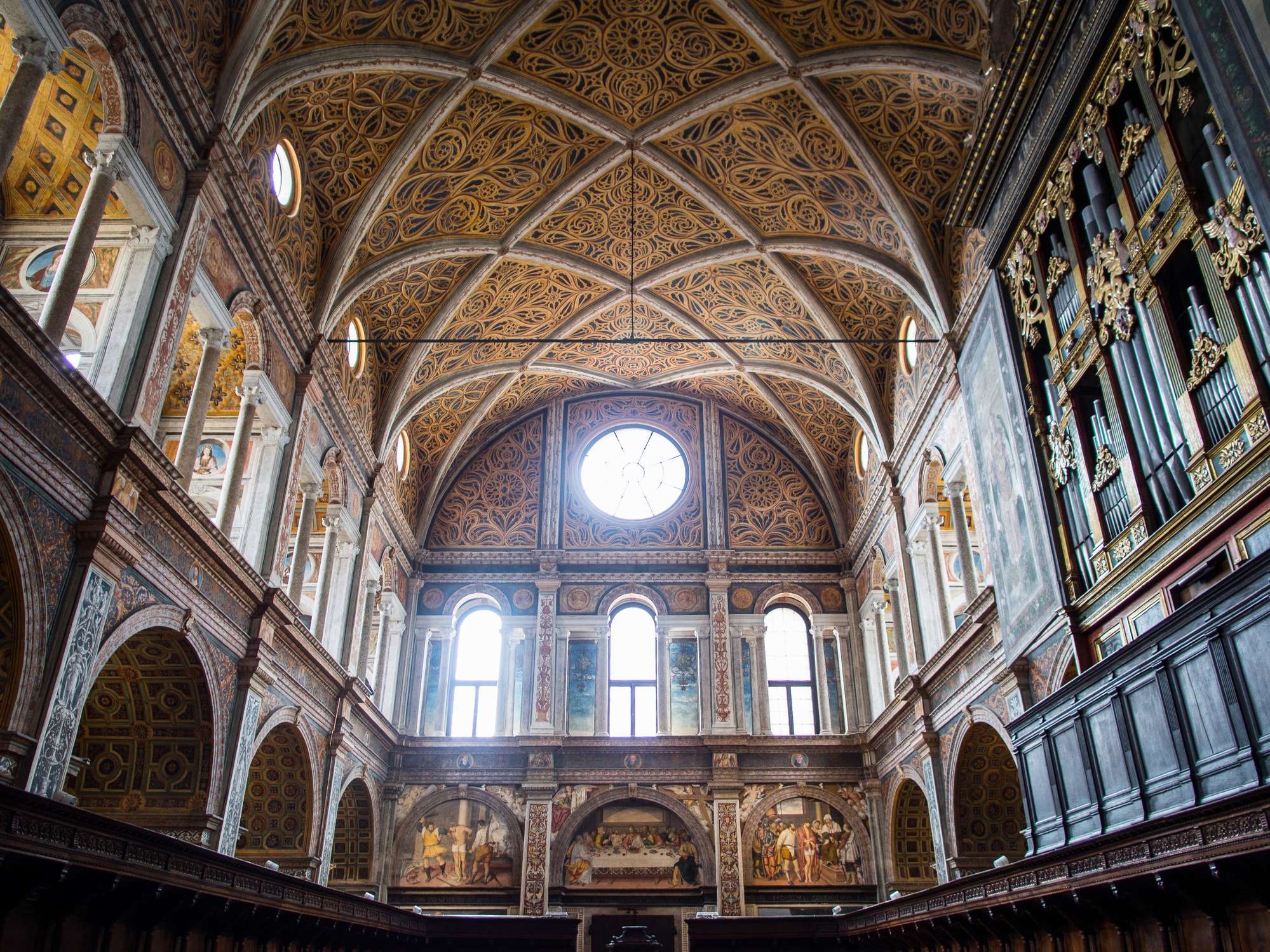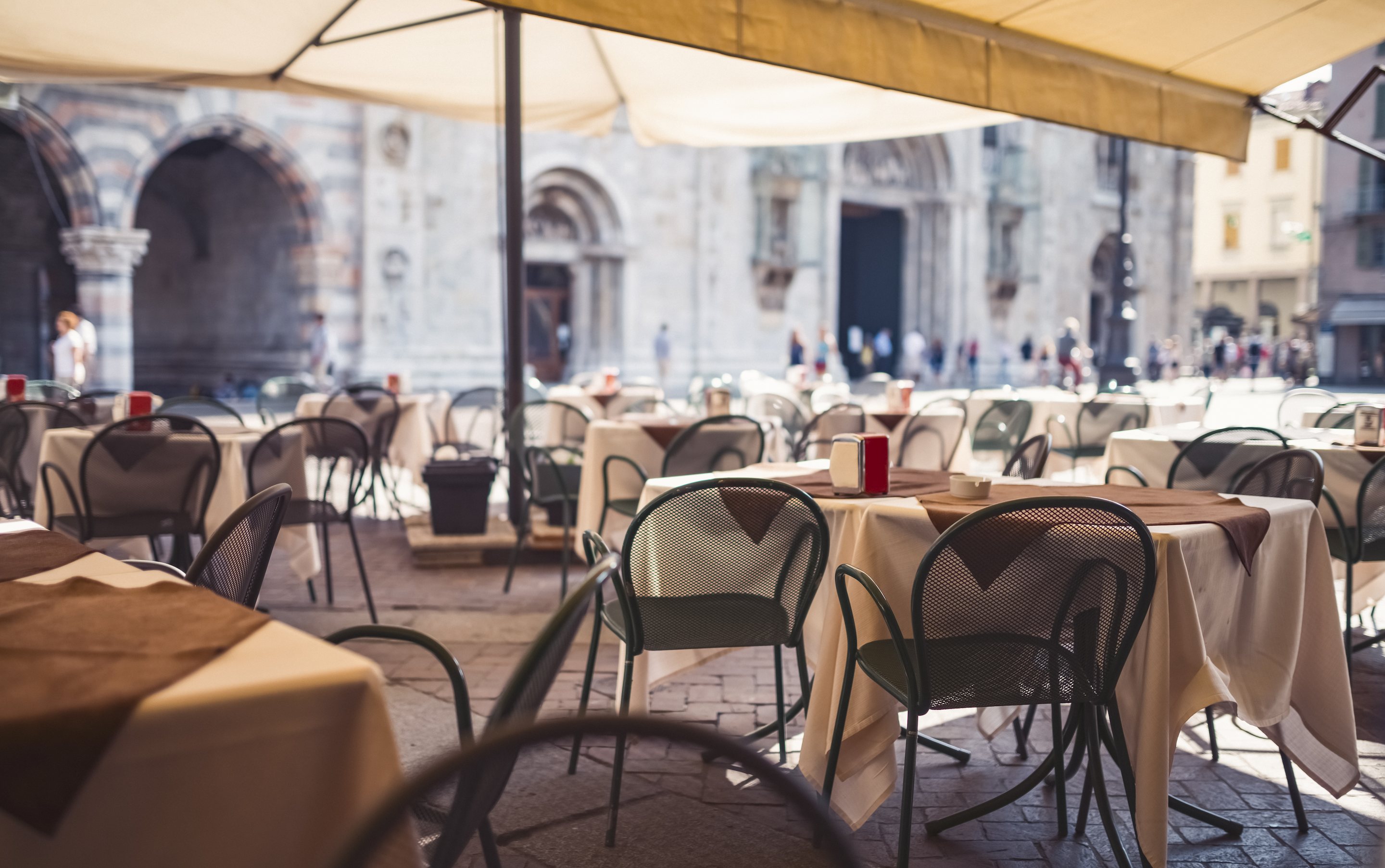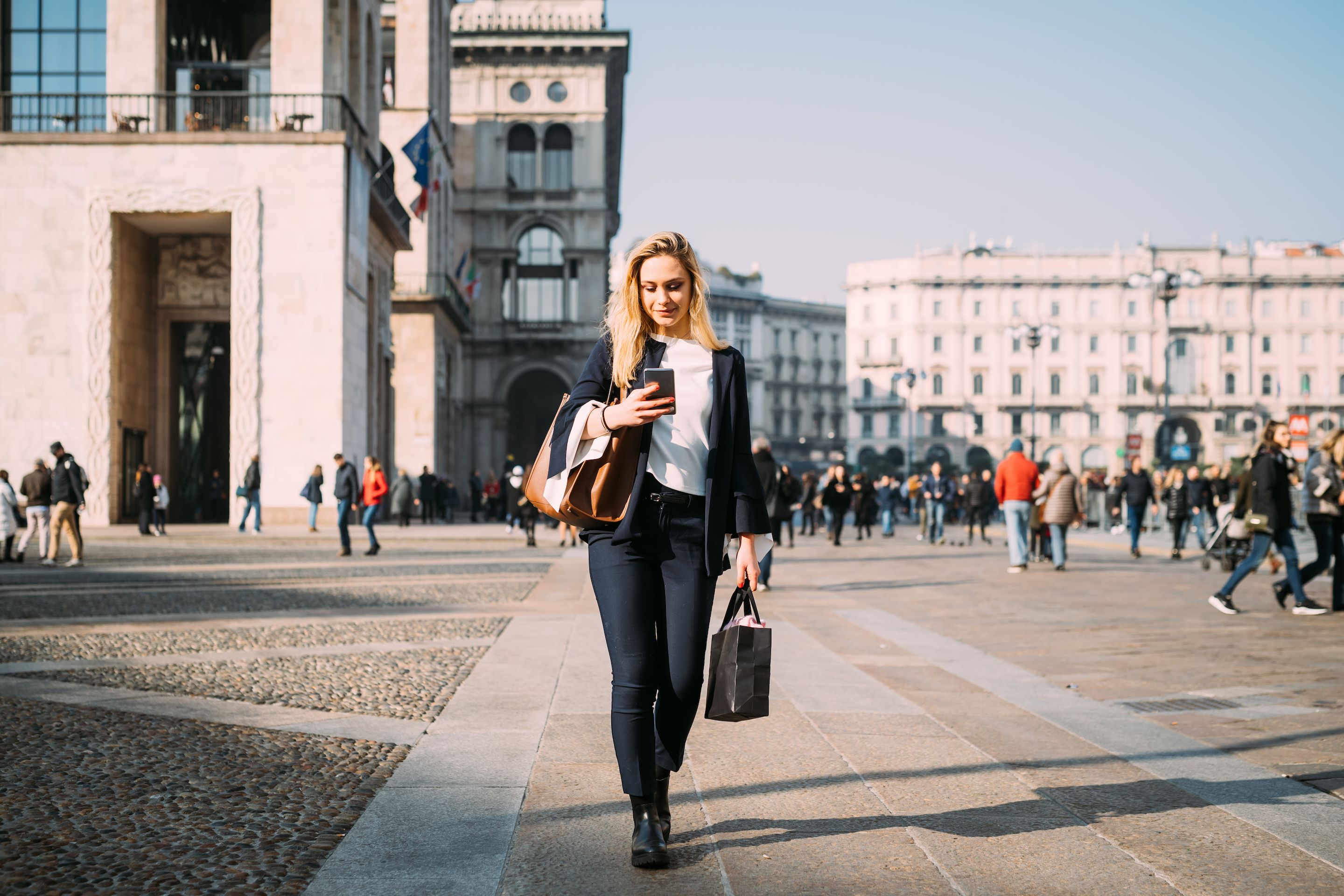If you didn’t know any better, you could easily walk past San Maurizio al Monastero Maggiore without a second glance. Only the crowds gathered at the entrance suggest that anything remarkable lies ahead. But step inside this church, and you’ll find a spectacular building.
Dubbed Milan’s Sistine Chapel, San Maurizio al Monastero Maggiore is one of the best-preserved churches in the city and features some world-class artwork.
What’s in this guide?
- San Maurizio Al Monastero Maggiore history and facts
- What to see at San Maurizio Al Monastero Maggiore
- Restaurants, bars and shops nearby
- Opening times and ticket prices
How to get to San Maurizio Al Monastero Maggiore
Overlooking the beautiful via Corso Magenta and a short walk from Castello Sforzesco (Sforzesco Castle) and Duomo di Milano (Milan’s Cathedral), San Maurizio al Monastero Maggiore is a landmark to visit after a day of sightseeing. If you’re heading there first thing in the morning, there are lots of ways to reach this magnificent church.
Go by metro on either the M1 or M2 lines, stepping off at Cardona or Cairoli stations. Alternatively, the 16,19 or 20 tram lines will take you to San Maurizio al Monastero Maggiore. If you’re travelling by bus, you’ll need to go on either the number 50 or 58.
Remember that if you’re planning on using public transport as your primary way of getting around the city, it’s best to think ahead and buy yourself a travel card.
Although single tickets are very affordable, opting for a travel card is an excellent way of saving money during your trip. We’d recommend buying the 48-hour travel card if you're there for a weekend. For just €8.25, you can use the card as many times as you’d like to get yourself around the city by metro, tram or bus.
San Maurizio Al Monastero Maggiore history and facts
With its intricate wall paintings (or frescoes), you won’t be surprised to learn that the San Maurizio church dates back centuries. It was once part of Monastero Maggiore, one of the most significant female monasteries in the city, from which the church takes its name.
Commissioned by the ruling Sforza family, San Maurizio al Monastero Maggiore was constructed in 1503 under the watchful eye of architect Gian Giacomo Dolcebuono. A wide range of materials was used to build the church, some dating as far back as ancient Roman times!
The dividing wall
Although built as one building, the church was divided by a central wall. One half, named The Hall of The Faithful, was reserved for the local worshippers, the other half for the convent’s nuns in the aptly named Hall of Nuns.
The dividing wall was a physical reminder to nuns that they were forbidden from crossing over to the Hall of The Faithful. This rule stayed in place until 1794. But Dolcebuono ensured that there were tiny grates in the dividing wall so that the nuns could listen in on the mass taking place on the other side.
Famous frescoes
Once the church was erected, the internal frescoes were painted by celebrated 16th-century artists, including Bernardino Luini, a Renaissance artist who was a student of none other than Leonardo da Vinci. In total, the church has over 40,000 square feet of frescoes, earning the church the nickname of Milan’s Sistine Chapel.
As you’d expect, most paintings depict scenes from the Bible and the lives of saints. The church also includes portraits of noble Milanese families from the Renaissance era. Carefully restored in recent years, the paintings are now in excellent condition for visitors to admire.
San Maurizio al Monastero Maggiore today
Today, San Maurizio church is a thriving Milanese landmark, where tourists flock to take in the breathtaking paintings. As most of Bernardino Luini’s art has been lost throughout the years, the church is also one of few places you can see his work.
If you’re considering adding San Maurizio al Monastero Maggiore to your itinerary, we’d recommend getting yourself a guide. They’ll be able to talk you through the story behind each painting, making sure you get the most out of your experience.
What to see at San Maurizio al Monastero Maggiore
With so many frescoes to admire, you can easily spend hours at San Maurizio al Monastero Maggiore. Here’s a quick round-up of what to look out for at this impressive church.
Hall of the Faithful
The side of the church that was created for the congregation, the Hall of the Faithful, was painstakingly hand-painted with wonderful Renaissance-style biblical depictions. Key ones to look out for include Bernardino Luini’s paintings of The Life of San Maurizio, which you can find on the dividing wall. Make sure you also visit Antonio Campi’s 1578 painting of The Adoration of the Magi on the main altar.
Hall of Nuns
Through a small opening on the left-hand side of the dividing wall, you’ll enter the Hall of Nuns. Arguably the most impressive side of the church, the Hall of Nuns features some outstanding frescoes that will blow you away.
Much more extensive than the Hall of the Faithful, the Hall of Nuns has six bays built to accommodate the nuns. On this side of the church, discover a 1573 painting by Venetian artist Simone Peterzano and even more depictions by Bernardino Luini, including portraits of saints. The ceiling is a particular highlight of the church, which features a painting of Christ surrounded by angels, with a striking navy background.
A fresco of The Last Supper is painted above an archway, through which two chapels can be found. The chapel on the left has a fresco of Noah’s Ark, which is considered one of the best in the entire church. Painted by Aurelio Luini, Bernardino Luini’s son, this painting is packed with details. Look closely, and you’ll spot a pair of unicorns on their way into the ark!
Wall paintings aside, the Hall of Nuns also houses another fascinating artefact. This is the home of the oldest organ in the city. Dating back to 1554, it was built by Gian Giacomo Antegnati and the case decorated by Francesco and Girolamo de’ Medici da Seregno. Astonishingly, it still works to this day!
Museo Archeologico
Parts of Monastero Maggiore have now been converted into Museo Archeologico (The Archaeological Museum). Featuring a variety of exhibitions from ancient Milan, including intricate mosaics, this is a great place to carry on exploring the history of this great city.
Head to the octagonal tower, and you’ll find exhibitions from the Early Middle Ages and the Etruscan era, along with Greek antiquities. You can also stroll the grounds and uncover even more hidden gems, such as the polygonal tower, which houses 13th and 14th-century frescoes of St. Francis.
Palazzo Litta
Cross the street, and here lies another Milanese landmark. Palazzo Litta is a baroque palace that has played host to some of the city’s most notable parties, entertaining royals from all corners of Europe. Now a cultural centre, it was initially built by Francesco Maria Richini between 1642 and 1648 for Count Bartolomeo Arese.
We’d recommend visiting Palazzo Litta while exploring San Maurizio al Monastero Maggiore, as it’s an exquisite example of Baroque architecture and features a beautiful courtyard too.
Restaurants, bars and shops near San Maurizio al Monastero Maggiore
One of many landmarks located in zone 1 of Milan, or Mi1, it’s no surprise that most restaurants, bars and shops are within walking distance from San Maurizio al Monastero Maggiore.
Restaurants
It’s always a good idea to research where to eat before you travel, wherever the destination. If you’re thinking you’ll need a bite to eat after visiting San Maurizio al Monastero Maggiore, here are our top choices:
- La Brisa – Literally around the corner from San Maurizio al Monastero Maggiore lies La Brisa. The setting for a magical evening, dine on the terrace or in the walled garden surrounded by lime trees for a night you won’t forget. The menu is just as elegant as the surroundings, with carefully crafted dishes including the favourite Iberian crispy pork
- Aimo e Nadia BistRo – For a traditional Milanese meal that’s beautifully simplistic, check out the Aimo e Nadia BistRo. A more laid-back version of the renowned double Michelin-starred Il Luogo di Aimo e Nadia, this restaurant is just over a 10-minute walk from San Maurizio church
- Felice a Testaccio – If you’ve tested out Milanese cuisine and are looking for something different, how about a Roman meal? Felice a Testaccio is a family-owned restaurant located in the heart of Milan. Opened in 2017, it’s the sister restaurant of the original Felice a Testaccio in Rome. Priding itself on fresh, high-quality ingredients and paying tribute to the family heritage, the dishes here are nothing short of outstanding
- Pasticceria Cucchi – Looking for something sweet to keep you going through the day? Get yourself to Pasticceria Cucchi, the renowned patisserie shop with pastries to die for – it’s only 12 minutes away!
Bars
Nothing beats a crisp drink in the glorious Milanese sunshine. And luckily, there are lots of bars to choose from near San Maurizio al Monastero Maggiore.
- Bar Magenta – Spending the afternoon exploring San Maurizio al Monastero Maggiore can be thirsty work. If you’ve just left the landmark and are looking for a quick drink, Bar Magenta is less than 5 minutes away on foot. Established in 1907, you know you’ll be in safe hands here. They have a food menu too, so if you need a light snack with your drink, they’ve got you covered
- Le Biciclette – Only ten minutes from San Maurizio church, Le Biciclette oozes artsy vibes, making it the perfect setting for a chilled-out evening after a busy day exploring the streets of Milan
Shopping
You’ve seen the landmark, now it’s time for the souvenirs. But where should you head to?
- Via Dante – Less than a 10-minute walk from San Maurizio church is Via Dante. The fully pedestrianised street is packed full of shops for you to browse in between your sightseeing. As this is located between San Maurizio al Monastero Maggiore and the Duomo, we’d recommend stopping here for a break and a quick lunch
- Corso di Porta Ticinese – If you’re looking for something a bit different, take a 15-minute walk to Corso di Porta Ticinese. Nicknamed Milan’s Portobello Road, you can explore a variety of independent boutiques and vintage stores and shop to your heart’s content. It’s known for selling great denim, so stock up on your jeans here
San Maurizio al Monastero Maggiore opening times and prices
You can visit Milan’s Sistine Chapel free of charge and spend as much time as you like admiring the abundance of hand-painted frescoes.
San Maurizio al Monastero Maggiore is open to the public from 10:00 to 17:30 Thursday to Sunday. The last admission is at 17:00, so it’s best not to leave visiting until the last minute.
Travelling by train to Milan?
If you're thinking of taking a trip to Milan, why not travel by train? Getting the train to Milan is easy thanks to the high-speed rail connections operated by Trenitalia and Italo. You can travel to Milan from some of the most popular cities in Italy, including from Venice to Milan (2h), Rome to Milan (2h 52m) and Florence to Milan (1h 40m).
Need more information about travelling to Milan by train? Check out our dedicated page to trains to Milan.




